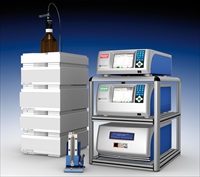Members Login

Channels
Special Offers & Promotions
New Whitepaper from Wyatt Technology On Branching in Synthetic and Natural Polymers
Wyatt Technology has published a new whitepaper
 Wyatt Technology Corporation, the world leader in absolute macromolecular characterization instrumentation and software, has published a new whitepaper on characterizing molecular structure in synthetic and natural polymers by multi-angle light scattering. Authored by Stepan Podzimek, Scientific Consultant for Wyatt Technology, the paper details the basic principles of the detection and characterization of branching by means of a multi-angle light scattering (MALS) detector and the various methods used.
Wyatt Technology Corporation, the world leader in absolute macromolecular characterization instrumentation and software, has published a new whitepaper on characterizing molecular structure in synthetic and natural polymers by multi-angle light scattering. Authored by Stepan Podzimek, Scientific Consultant for Wyatt Technology, the paper details the basic principles of the detection and characterization of branching by means of a multi-angle light scattering (MALS) detector and the various methods used.
The whitepaper outlines research into the abnormal elution behavior of branched macromolecules in size exclusion chromatography (SEC) and explains the comparative data acquired by SEC-MALS and asymmetric flow field flow fractionation (A4F). The comparison of SEC-MALS and A4F-MALS proves superior, artifact-free A4F separation of large and highly branched macromolecules compared to their abnormal separation by SEC.
Highlighting the significant impact branching has on the properties of the structural parameter of synthetic and natural polymers; the whitepaper acknowledges the importance of quantitative branching topology information, for the development of novel polymer-based materials and for understanding polymerization processes. Using Wyatt Technology instruments: a MALS photometer DAWN® HELEOS®, an online viscometer ViscoStar™, a refractive index detector Optilab® T-rEX™ and an A4F system Eclipse™ AF4; Dr. Podzimek successfully analyzed branching in poly(lactic acid). Wyatt instrumentation provided a solution to previous challenges in branching studies, with the characterization of branching by means of size exclusion chromatography (SEC) or asymmetric flow field flow fractionation (A4F), previously not possible without a multi-angle light scattering detector.
Stepan Podzimek comments; “In order to identify and characterize branching, one needs information about the molar mass and the molecular size. That is exactly the power of using a multi-angle light scattering detector: it provides both pieces of information simultaneously and independently. The MALS detector is usually connected to an analytical separation technique - most commonly SEC - to determine branching parameters as a function of molar mass. Typically the parameters of interest are the branching ratio and the number of branch units per molecule. Wyatt MALS photometers allow direct determination of branching ratio g and number of branch units per molecule.”
The MALS photometer DAWN® HELEOS®, used in the study, is an 18-angle light scattering detector for the measurement of absolute molecular weight, size, and conformation of macromolecules in solution. Used specifically in this instance, to detect branching in hyaluronic acid, an important biopolymer with numerous media and pharmaceutical applications which was until recently believed to have a linear structure; the DAWN® can be used for continuous flow detection following chromatographic separation, or off-line as a stand-alone unit in batch or microbatch mode. For more information on the Optilab® T-rEX™, Eclipse™ AF4 and DAWN® HELEOS®.
About Wyatt
Based in Santa Barbara, California, Wyatt Technology is the world’s leading provider of instruments for absolute macromolecular and nanoparticle characterization. With over 40 years’ experience developing multi-angle light scattering detectors, working with customers in the biotechnology, chemical, petrochemical, pharmaceutical, academic and government arenas, Wyatt prides itself on its entrepreneurial spirit, and the uniqueness of its offerings. The Company’s groundbreaking technology and uncompromising levels of customer care make Wyatt the global benchmark in its field.
Media Partners


